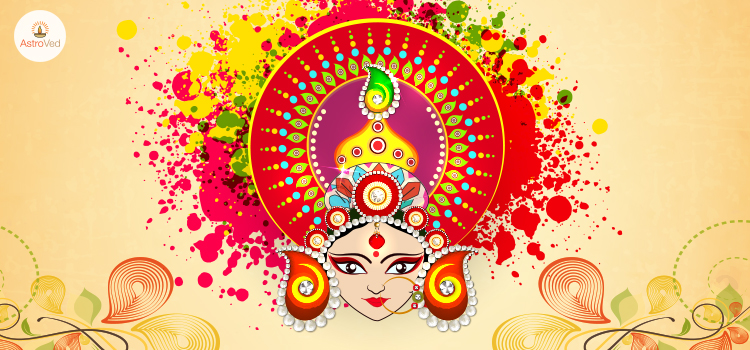How To Perform Navratri Pooja
About Navratri Pooja
Navaratri is one of the most auspicious and sacred festivals observed on the Indian subcontinent. The festival pays tribute to Goddess Durga, the embodiment of virtue and Divine feminine power (Shakti) of the universe. This nine-day extravaganza celebrates the triumph of good over evil, with each day being observed grandly. The festival is celebrated all over India, and more so in Maharashtra, Gujarat, Karnataka, and West Bengal. The festivities are not restricted to homes alone but are also observed in Sarvajanik Pandals. These pandals are specially erected structures on which the idol of the Goddess is placed and worshiped. Each pandal is innovatively decorated, keeping in mind relevant social issues and themes to convey the message to the masses. Men and women dressed in traditional attire dance and sing until the wee hours every night during this nine-day-long festival.

Navaratri period and festivities
The Navaratri festival begins on the new moon day of the 'Ashvin' month, which falls sometime during September-October. This period is known as Sharada Navaratri. However, 'Vasanth Navaratri' is also celebrated in the month of April. During the course of the festival, young girls are deified and clothed in new attire every day. This nine-day festival is also highly auspicious for unmarried girls as well; in general, this is a period when women are respected and honored.
Significance of Sarvajanik pandals
One of the important and striking features of the Navaratri festival is the Sarvajanik pandals, which are erected specially for the occasion. An image of the deity is housed in these pandals and worshiped on a regular basis. All are welcome to participate in the Pujas and rituals conducted in these pandals, and many even organize Garba and Raas (folk dance forms) performances. These tastefully decorated and spacious pandals are synonymous with the Navaratri festival.
Navaratri Puja celebrations
The house is properly cleaned and tidied up before the start of the Navaratri Puja celebrations. An idol of Maa Durga is then placed in on a decorated portion of the northern corner of the house. The rituals begin with planting 'Navaratri Jhuwara' or Navratri Jawara (germinated wheatgrass) in an earthen pot on the first day of the festival. A wide-mouthed pot is filled with sand and 'Juan' or wheat kernels that have been soaked overnight. These are then watered every day and kept out in the sunlight periodically.
Puja celebration begins with the decoration of the Kalash. Place mango leaves on the mouth of a Kalash filled with water. A coconut is then placed on the mouth of the Kalash. The neck of the Kalash is then tied with a 'moli' (string). An image of Goddess Durga is then placed atop a small wooden plank and worshiped with Roti, Rice, Flowers, Bel Pattar (Vilva leaves), Sindoor, Abhir (Fragrance Powder), along with some 'Holi Gulal' (Color Powder).
Now, take a clay pot and put burning cow dung or a burning coal ember in the pot. Ghee is then added over the coal to make the flames leap out. Offerings like Sweets like Laddoo and Peda (Milk Sweet) are also placed on them. Keep adding ghee at periodic intervals. The flames should be kept burning bright while the Puja is being performed and Durga Aarti is recited. After the Puja, those who have observed a fast can now take food.
Food During Navratri
Consumption of flesh any form of meat is strictly prohibited during the festival of Navaratri, and all meals are strictly vegetarian. The food prepared on this day does not even include garlic or onion. Those who observe a fast consume only one meal a day; however, this may include several items.
Kuttu Ki Roti, Sabudana Khichdi, and Kuttu Ki Pakore are the traditional food items prepared and consumed on this day. People also consume fruits during the fasting period. Rice Kheer, Puri, Kala Chana, and one or two vegetable dishes are cooked on the eighth day. It is also a tradition to invite young unmarried girls and serve them food to . They are then sent home after being given some money as a token of respect.
Navaratri Gifts
It is a practice to exchange gifts, sweets, and greetings during the Navaratri festival period. Some of the favorite items are images of Goddess Durga, which are given to family members and friends. Silver coins, calendars, and dry fruit boxes are also some of the popular items which are exchanged on this day. Those with deep pockets can also consider gifting their close friends and relatives with pilgrimage tours.
Navaratri Greetings
The advent of modern technology and social media platforms has opened up various means of greeting each other. Popular avenues used to convey greetings nowadays are Facebook, WhatsApp, LinkedIn, etc. Using these platforms, one can reach out to a larger audience and convey Navaratri greetings in an effective manner.




















